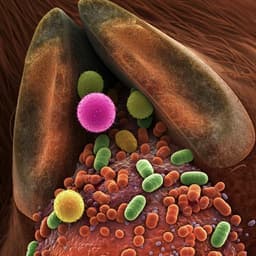
Medicine and Health
Intersecting social and environmental determinants of multidrug-resistant urinary tract infections in East Africa beyond antibiotic use
K. Keenan, M. Papathomas, et al.
This study explores the intricate factors contributing to multi-drug resistant urinary tract infections in East Africa, revealing associations between social and environmental disadvantages and the risk of MDR UTIs. Conducted by a collaborative team of researchers, it emphasizes the urgent need for targeted interventions in vulnerable communities.
~3 min • Beginner • English
Introduction
Antibacterial resistance is rising globally, with particularly high burden anticipated in low-resource settings such as East Africa. While most interventions focus on optimizing antibiotic use, the drivers of ABR extend beyond prescribing behaviors to include cultural, socioeconomic, infrastructural, political, and environmental factors that may operate synergistically. Within a One Health framework, the study aims to understand how behavioural, environmental, socioeconomic, and demographic factors jointly relate to the burden of MDR urinary tract infections. The research questions are: (1) How are these factors jointly associated with higher risk of MDR UTI? (2) How do environmental, social, economic, behavioural, and demographic factors relate to MDR UTI burden in East Africa?
Literature Review
Prior research identifies antibiotic use in humans and animals as a core driver of ABR and MDR, especially in contexts with easy non-prescription access and empirical prescribing due to limited diagnostics. However, AB use correlates with broader vulnerabilities such as poor health status, chronic illness, prolonged hospital stays, poor sanitation, and close contact with waste and animal products. Studies also point to demographic and clinical risk factors for MDR UTIs, including older age, gender, surgery, hospitalization, and invasive procedures. Structural poverty and WASH deficits are implicated in ABR colonization and transmission, with One Health risks from proximity to livestock and consumption of animal products where ABs are used. Ecological cross-country models highlight macro drivers like poor WASH, corruption, socioeconomic inequality, population density, and weak regulation. Linked individual-level One Health studies in LMICs suggest cultural-ecological transmission pathways (e.g., handling/consuming milk/meat) and household/livestock interactions as strong drivers, sometimes exceeding recent AB use. Yet, many studies rely on regression frameworks that may obscure complex interrelationships, underscoring the need for integrated data and methods that capture synergistic effects.
Methodology
Study design: Cross-sectional, One Health framework across nine sites in Kenya (Makueni, Nairobi, Nanyuki), Tanzania (Kilimanjaro, Mbeya, Mwanza), and Uganda (Mbarara, Nakapiripirit, Nakasongola). Recruitment occurred February 2019–September 2020 in predominantly government-funded primary, secondary, and tertiary facilities.
Sample and data collection: 6827 adult outpatients (≥18 years; pregnant adolescents 14–18 years ~1%) with UTI-like symptoms were recruited; <1% declined. Mid-stream urine samples and a clinic-based questionnaire (treatment-seeking, AB use, health, AB knowledge/attitudes, socio-demographics) were collected (n=6804). Microbiologically confirmed UTI was defined as >10 CFU/mL of one or two uropathogens. Among those with confirmed UTI who consented, household follow-up occurred ~1 month later (mean 31 days, IQR 5–42) with a household questionnaire (composition, socioeconomic factors, sanitation/hygiene, illness/health-seeking, livestock practices) and environmental observations (sanitation, livestock, hygiene). Data were linked via anonymous identifiers. Flow: Confirmed UTI n=2332; AST performed for n=2063; exclusions for species ID and non-bacterial isolates; final analysis sample n=1610 with valid AST linkage and completed household visit (Kenya 648; Tanzania 581; Uganda 381).
Microbiology and outcomes: Pathogen identification and AST followed CLSI 2021 zone diameter criteria. Primary outcome: MDR UTI (binary), defined as resistance to at least one agent in three or more antimicrobial categories per ECDC definitions, modified to include nitrofurantoin and trimethoprim; for species not covered by ECDC (Salmonella spp., Shigella spp., Streptococcus spp.), MDR was calculated using a selected pool of tested ABs. In the main analysis, intermediate AST results were considered resistant; sensitivity analysis reclassified intermediates as susceptible. Secondary outcome: East Africa-specific ABR (EA ABR), defined as resistance to any AB recommended in national guidelines for uncomplicated UTI in each country.
Covariates: 67 variables from clinic and household questionnaires, environmental observations, and geospatial data, spanning location/context, community One Health (livestock, manure, waste), household WASH and socioeconomic factors, individual health and sociodemographics, treatment seeking and AB use, knowledge/attitudes, and microbiological features.
Statistical analysis: Exploratory bivariate analyses used chi-square tests with false discovery rate control. Bayesian profile regression (PReMiuM R package v3.2.1; R v4.3.2) clustered patients on the covariates and associated clusters with MDR UTI risk, with built-in variable selection (selection probability >0.69 indicating importance). Missing data (max 3.4% per variable) were imputed within the MCMC. Cramer's V assessed inter-variable and outcome associations among important variables. Predicted MDR rates were computed for profiles defined by multidimensional poverty and by high/low risk characteristics using the fitted model and calcPredictions. Sensitivity analyses included women-only (adding pregnancy/parity), Gram-negative subset, and alternative ABR outcome (EA ABR). Ethical approvals and informed consent procedures were obtained in all settings.
Key Findings
- Prevalence and sample: Overall MDR UTI proportion was 48% across the analysis sample (n=1610). Sites in Kenya and Nakapiripirit (NE Uganda) had proportionally lower MDR than others.
- Bivariate associations: 23 of 67 variables were significantly associated with MDR UTI (FDR-adjusted p<0.05). Higher MDR was observed among patients recruited in secondary/tertiary vs primary care (52% vs 43%); households using manure; proximity to rubbish dumping; pit latrine use; unprotected washing/drinking water; inconsistent handwashing with soap; lower education (patient and household head); older age (>45 years); house ownership; lack of computer ownership; no obstacles to accessing medicines; household member working in a hospital; reported antibiotic sharing; HIV/AIDS; disability; recent surgery or inpatient stay; unfamiliarity with the term 'antibiotic'; treatment delays; government clinic attendance; recent AB use for UTI; and treatment failures.
- Bayesian profile regression: 24 clusters were identified (cluster sizes 17–127) with median MDR risks ranging from 0.26 to 0.72; 42 of 67 variables were important for cluster allocation. High-risk clusters were more common in Tanzania and Uganda than Kenya. Key high-risk characteristics included: livestock keeping; use of antibiotics to raise livestock; contact with animal manure; proximity to rubbish dumping; sick household members; private flush toilets or pit latrines; unprotected washing/drinking water in the highest-risk clusters; lower education of household head and patient; lack of health insurance; house ownership; greater familiarity with AB packaging; treatment delays; more complex care-seeking; recent AB use and treatment failures; age ≥45. Low-risk clusters tended to show handwashing with soap, electricity, health insurance, secondary education (patient and household head), obstacles to accessing medicines, and less complex or direct-to-clinic care-seeking, among others.
- Predicted disparities: Individuals with all low-risk profile characteristics had a predicted median MDR UTI rate of 31% versus 64% for those with all high-risk characteristics, with site-specific differences always ≥20 percentage points. Disparities were smaller when using a priori multidimensional poverty measures based only on education and living standards.
- Sensitivity analyses: Women-only sample (n=1369) yielded 8 high-risk and 5 low-risk clusters with broadly similar patterns; having ≥4 live births emerged as an additional risk factor. Gram-negative subset (n=1009) showed similar important variables; Gram-positive subset was underpowered. Using EA ABR as outcome produced 25 clusters with median prevalence 11–88%; four variables that were important for MDR clusters (work status, private clinics, treatment delay, heard of ABR) were not important for EA ABR. Reclassifying intermediate AST as susceptible reduced MDR prevalence from 48% to 38% and yielded 25 clusters (6 high-risk, 7 low-risk) with similar patterns.
- Overall inference: Over 40 environmental, social, and economic variables jointly associate with MDR UTI, indicating intersectional, synergistic drivers beyond antibiotic use alone.
Discussion
The findings demonstrate that MDR UTI risk in East Africa is shaped by an intersection of sociodemographic, socioeconomic, environmental, and behavioural factors operating synergistically. Older age, lower education, household illness burden, limited assets, WASH vulnerabilities (e.g., proximity to animal manure and rubbish, inconsistent handwashing), and livestock-related exposures cluster together with complex treatment pathways and recent antibiotic exposure, producing substantially elevated MDR risk. While antibiotic use is an important proximal driver, it did not consistently correspond to higher MDR risk in isolation, underscoring that antibiotic use behaviors are embedded in broader material and social contexts. The Bayesian profile regression approach captures interrelations that conventional regression may obscure, revealing high- and low-risk profiles that can guide targeted, context-sensitive interventions. The results support shifting from purely behavior-focused stewardship to strategies that also address underlying structural and environmental determinants, including WASH improvements, health system strengthening, and socioeconomic deprivation, to more effectively reduce ABR burden.
Conclusion
This study integrates One Health, household, and individual data with Bayesian profile regression to reveal how more than 40 intersecting social and environmental factors jointly shape MDR UTI risk in Kenya, Tanzania, and Uganda. It advances understanding beyond antibiotic-centric explanations by identifying characteristic high- and low-risk profiles and quantifying large predicted disparities (approximately 64% vs 31% MDR prevalence). The work underscores the need for interventions that combine antimicrobial stewardship with actions addressing WASH, environmental exposures, and socioeconomic disadvantage. Future research should use longitudinal designs and integrated genomic-epidemiologic approaches to establish directionality, distinguish ABR development from transmission, refine outcome definitions, and identify cost-effective, context-specific intervention points. The HATUA program plans to leverage genomic data and develop integrated surveillance focused on variables identified as important here.
Limitations
- Study population represents adult outpatients with UTI-like symptoms at mainly public facilities, limiting generalizability to the broader population and to other infections.
- Socio-demographic and behavioral measures are self-reported, introducing potential misclassification and recall bias.
- Strong site-to-site variability likely proxies unmeasured structural, political, and economic differences at sub-national scales.
- COVID-19 restrictions affected recruitment, particularly in Kenya (shorter sampling period, fewer and higher-level facilities), and the Kenyan sample included proportionally more Gram-positive infections with higher resistance rates.
- Limited sample sizes precluded detailed stratification by all sub-national sites, by sex (men), and by all bacterial species.
- Cross-sectional design prevents inference on temporality and directionality between exposures and MDR outcomes.
- Trade-offs between breadth of multi-site sampling and depth of context-specific measurement; some relevant factors may remain unmeasured.
Related Publications
Explore these studies to deepen your understanding of the subject.







